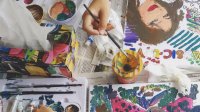Online Archives: Fun and Fascinating Classroom Resources
From an online collection of visual archetypes to royalty free music, these resources are great for the classroom or for just taking a fun trip down the rabbit hole of history.
I'm both a history buff and a media geek, and the last 20 years have provided a treasure trove of historical documents, photographs, and recordings that have been digitized and made available online. I'm also an artist and art teacher.
I'd like to share some of my favorite online archival resources along with some examples of how I've used them in the past. I'm especially fond of the libraries and museums that provide this material for free or for a small fee. These resources are all run by nonprofits and are not driven by a profit motive -- a rare find these days online and off.
From an online collection of visual archetypes to royalty free music, these resources are great for the classroom or for just taking a fun trip down the rabbit hole of history.
The Internet Archive
Before YouTube and Vimeo, there was the Internet Archive. I've used this to help students find educational documentaries from the 1950s, which gives a great insight into what (and how) kids learned in the past. The Internet Archive is a great resource for finding historic documentaries and recordings. They also have the Wayback Machine, an archive of websites that no longer exist.
ARAS
In the art class I teach, I asked students to find visual archetypes relating to things they care about, such as love, family, and traveling. They then build their own visual library of images that they can draw upon for inspiration in their artwork. ARAS helps by providing archetypical imagery from different cultures and historical periods, organized around themes. (This site does require a paid membership.)
New York Public Library
For my own art projects, I work with photographs from the past, specifically those of African Americans in the American south of the 1930s and 40s. The New York Public Library has gathered together various collections of primary sources and made them available to the public. Highlights include such things as the papers of Alexander Hamilton (before he became a Broadway hip hop star), and photographs from the Workers Project Administration programs founded under Franklin Roosevelt.
Cylinder Songs
Before downloadable music, there were CDs, and before CDs, there was vinyl, and before vinyl? Most of us are unaware that the very first music recordings were made on cylindrical devices made of tinfoil, wax, and eventually plastic, and the University of Santa Barbara has made over 10,000 available.
The age of these recordings are remarkable. Many are from the 1890s. What is also fascinating is the range of novelty recordings and 19th-century popular music that is available. They provide a window into how the popular imagination was shaped 100 years ago. In addition to music, one can also find vaudeville acts and dialogues. Many topical issues of those times are addressed in these recordings, sometimes in ways that are offensive because of the casual racism and stereotyping.
Spanish Civil War Posters
Another great resource for both graphic design educators and history teachers is the University of San Diego's archive of Spanish Civil War Posters. For graphic designers, these bold designs represent a golden age and inspiration, and for teachers of the 20th century, they show the use of propaganda. Students can get both a sense of the urgency and issues relating to that first great fight against fascism in Europe.
Jamendo
Since I teach students how to make movies and music, I am always mindful of the use of copyright and fair use in the classroom. More importantly, I like students to go beyond the obvious of the copyright issues of popular music. Jamendo provides access to music that comes under the Creative Commons license. Creative Commons was developed by a group of lawyers and internet pioneers who wanted to expand what they believe are the limitations of conventional copyright.
Specifically, they have created a license that gives the artists and listeners more control than the record companies. Under Creative Commons, the artist can specify the type of use that is allowed, and very often this music is royalty free as long as the musician is given credit and it is not used for commercial purposes.
How might you use these resources in your classrooms? What are your go-to online archives for both fun and learning? Please share in the comments section below.
